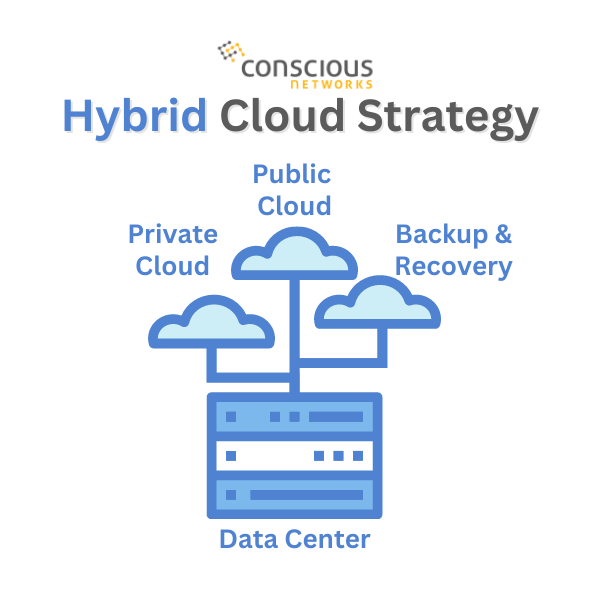Best Practices for a Hybrid Cloud Strategy
As businesses strive to increase the productivity and efficiency of their technology, processes, and systems, the hybrid cloud strategy is something worth considering. The digital transformation journey begins with a solid plan for your data. In this article, we will discuss the best practices for a hybrid cloud strategy.

What is a Hybrid Cloud Strategy?
A hybrid cloud strategy is a plan for businesses and organizations to evaluate and determine the best place to store applications and data. In a typical cloud strategy, considerations for how data is stored and which data should be accessible on a public cloud infrastructure, a private cloud infrastructure, or a private data center. In addition, a solid backup and recovery plan for each must be implemented to complete the process.
Who Needs a Hybrid Cloud Strategy?
As small and medium-sized businesses contemplate their IT infrastructure, a hybrid design can provide many benefits. Many businesses have maintained their own infrastructure for some time, but have recently found the need to support global or virtual workforces and client bases. This is a good time to examine your options. If you are considering a refresh or expansion of your technology or IT architecture, a hybrid cloud strategy may be a worthwhile endeavor.
One such choice that has many benefits is a combination of a computing environment that combines on-premise and cloud-based infrastructure to enable the sharing of applications and data across physical locations and multi-cloud environments. This allows organizations to balance the security and control provided by on-premise infrastructure and the flexibility and benefits found with a public cloud environment.
A Hybrid Structure Provides Elasticity
There are several benefits to the hybrid design and, depending upon organizational and operational model, the choices for implementation may vary widely. One of the biggest advantages to the structure, is the ability to add storage instantly, as the organizations data load increases. This can be particularly helpful during peak seasons or heavy volume. Cloud storage can be added, on the fly, using the resources of the cloud provider, almost instantaneously. This type of bandwidth and elasticity is extremely valuable to businesses who previously had to anticipate, plan for, and maintain a variety of resources, hardware, and software. Not only does this approach eliminate all of the associated costs with keeping storage in-house, it also increases capability and efficiency, at the push of a button.
A Hybrid Approach is Key for Small-Medium Businesses
The benefits of a hybrid environment used to be reserved for enterprise and large organizations, but many of these strategies are even more ideal for small and medium size businesses. The ability to scale quickly and reduce costs, while maintaining operational control and security, are factors that serve organizations of all sizes – today and with anticipation of future growth.
At Conscious Networks, we work as technology advisors to businesses of all sizes. We believe that by understanding your current technology, business operations, and long-term goals we can make better recommendations on the costs and resources that are most affordable and appropriate for your business. By contrast, many cloud providers simply sell storage, products, and services without an eye on the costs associated with rapid or sudden expansion. This is where a holistic technology approach can be beneficial.
Create a Technology Partnership
As mentioned previously, you will want to create a technology partnership rather than simply buying cloud services. A valued IT technology partner will take into consideration the costs and resources needed today, as well as the costs and resources associated with forecasted growth. You’ll want to carefully examine Service Agreements to ensure that you own your data and that there are redundant measures in place to secure and backup the data.
If you are required to maintain protocols for security and compliance, many public cloud infrastructures will require additional considerations.
A Hybrid Approach Still Requires a Strong Backup Plan
Just because your data is in the cloud does not mean that your cloud provider will have a strong backup and recovery plan. Before you move forward with any hybrid strategy, Conscious Networks recommends considering not only how you will use data on each platform but how and where data will be backed up and recovered from and by whom. A comprehensive backup and recovery plan is also critical to ensure that, in the event of a crisis, all of your data can be restored quickly. After all, your business depends on having accessible data to keep you up and running. If your cloud provider is hacked, you may be getting in line with a lot of other companies to get your data restored.
If your organization is considering a hybrid approach to data management, Conscious Networks would welcome the opportunity to discuss your visions and goals. Call or click to schedule a consultation.



